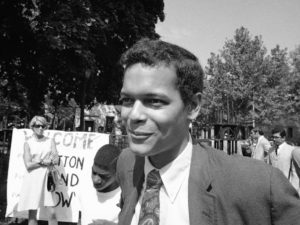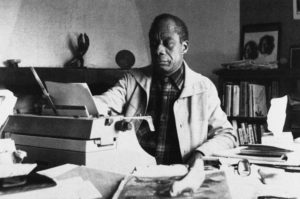Race and Class, Past and Present
Avery Arlington, the main character of the novel "Elsewhere, California," is someone you know: the awkward, only black girl in class, the girl hanging out at the 7-Eleven magazine rack wishing she was anybody but herself, and the artist whose work makes you uncomfortable.Avery Arlington, the main character of the novel "Elsewhere, California," is someone you know.
“Elsewhere, California” A book by Dana Johnson
You’ve probably never heard of Avery Arlington, the protagonist of Dana Johnson’s novel “Elsewhere, California,” but you know her. She’s the childhood friend whose parents moved her out of the ’hood, and you never saw her again. She’s the awkward, only black girl in class. She’s the preteen who lingers at the magazine rack in 7-Eleven dreaming about being anyone other than who she is. She’s the college roommate or classmate who always looked and acted like she didn’t quite belong at an elite private institution. She’s the drunk, hot undergrad throwing herself at you for attention. She’s a ride-or-die Los Angeles Dodgers fan. She’s the woman with a class complex because it was her love for a man and not her hard work that lifted her out of poverty. She’s the artist whose installations on race and class make you uncomfortable when you view them.
And if you know Avery, Avery certainly knows you. She knows you love a good story, a good baseball game, good food and good music. She knows you love your family members, imperfect as they may be. She knows you think much, much more than you would ever say aloud. Avery resonates with an intimate part of our lived experiences. Dana Johnson’s narrative has no bells, no whistles, no fancy literary conventions. “Elsewhere, California” is awash in the mundane. At times, the story drags because Avery’s day-to-day life is so pointedly pedestrian.
The novel’s prologue begins with Avery’s childhood, and establishes Johnson’s device of alternating between the points of view of Avery as a girl, and Avery as a woman. Girl Avery’s voice is full of errors in grammar and punctuation, while woman Avery speaks in ironed-out, proper English.
Avery is an awkward girl, conscious that others think her lips are too big and her body too fat. She’s displaced in West Covina after a series of violent events drive her parents out of Los Angeles. She meets Brenna, a bit of a wild child, and the two of them wander the streets of West Covina looking for something to do. They mostly listen to music, and fantasize with the aid of magazines. Avery’s cousin Keith adds excitement to their life. Keith is daring, irreverent and fun — the very characteristics that his single mother can no longer tolerate — so he also ends up in West Covina with his aunt and uncle. Keith and Avery are the same age, and mostly share a brother/sister bond except for an odd sexual tension — childhood kissing and fondling — that is finally resolved when 14-year-old Brenna is impregnated by Keith. He is returned to his mother and a life of more trouble that includes intermittent imprisonment.
Avery is an awkward woman, conscious that she intentionally presents herself very boyishly. She’s an artist who spends most of her time thinking things that she does not say aloud. She’s partnered with Massimo, a wealthy Italian immigrant and attorney who loves her dearly but never fully understands her — and he certainly doesn’t understand why she insists on hanging a portrait of herself and Keith kissing, naked from the shoulders up, in their hallway. Living with Massimo in the Hollywood Hills has removed Avery from the everyday experience of poverty but made poverty’s memories much more vivid. One day Keith breaks into the house and steals a few valuables, including the painting. Avery reflects that day on how she and Keith started in the same place but ended up worlds apart.
Avery’s life is defined by distance. Her parents’ 30-mile move from 80th and Vermont in Los Angeles to West Covina altered the 9-year-old’s identity, and ultimately changed her into a stranger whom her parents could not completely understand. Their own history was rooted in Tennessee. Avery and Massimo, living even farther away from her past in the Hollywood Hills, share the same space. They eat, talk and make love passionately together, and yet the ocean that divides their experiences with poverty, childhood and family can never be fully traversed. All of these distances are spanned in Avery’s portraits and collages. Race and class collide in her art at the intersections of past segregation and present integration, past poverty and present economic excess.
The narrative moves quickly and slowly at the same time. At the end of every section narrated by the older Avery is a row of asterisks. The marks and the spaces behind them vigilantly separate womanhood from girlhood, and create a barrier between who Avery was and who Avery became. Girl Avery’s story spans approximately 30 years. Woman Avery’s narrative, which is interrupted by girl Avery’s, covers about a single day. It is a profound commentary on the nature of time and memory. The past is full of detailed remembrances, yet the fleeting present can develop memories only once it has passed.
|
To see long excerpts from “Elsewhere, California” at Google Books, click here. |
When Avery meets one of Massimo’s colleagues near the end of the book, she dislikes her because “she didn’t understand anything about space, distance and time.” These three elements are certainly the core of this story. The gaps between them are artfully mediated by baseball, food and music. Baseball connects Avery’s childhood and adult relationships. Neither her mother nor Massimo understand her passion for the game, but they tolerate it because they love her. Avery’s love for her father is in part built on their shared affection for baseball. In addition to bridging the time between childhood and adulthood, baseball narrows the space between people. Woman Avery observes, “In baseball, everybody was the same because we all bled Dodger blue. Who was this person giving me a high-five? There was no way to tell, except we were all on the same team.”
Avery loves food. Her mother hastily feeds her fried mackerel and beans with fried greens and bacon when they have nothing else. Massimo prepares and serves extravagant meals to show his love. He cannot understand why Avery reaches back to her past by eating cold Pop-Tarts.
Finally, music runs through the book. A soundtrack accompanies every transition in Avery’s life. Whether Donny Osmond, The Commodores, David Bowie, “The Sound of Music,” Michael Jackson or Diana Ross, there is always music in Avery’s life. It roots her experiences in the past, and her music memories connect with readers’ own.
Baseball, food and music are the commonplaces that fill the space, distance and time in Avery’s life. Johnson reminds readers that we can also mediate the space, distance and time that separate us from ourselves by looking closely at the mundane substance of our daily lives.
Your support matters…Independent journalism is under threat and overshadowed by heavily funded mainstream media.
You can help level the playing field. Become a member.
Your tax-deductible contribution keeps us digging beneath the headlines to give you thought-provoking, investigative reporting and analysis that unearths what's really happening- without compromise.
Give today to support our courageous, independent journalists.










You need to be a supporter to comment.
There are currently no responses to this article.
Be the first to respond.